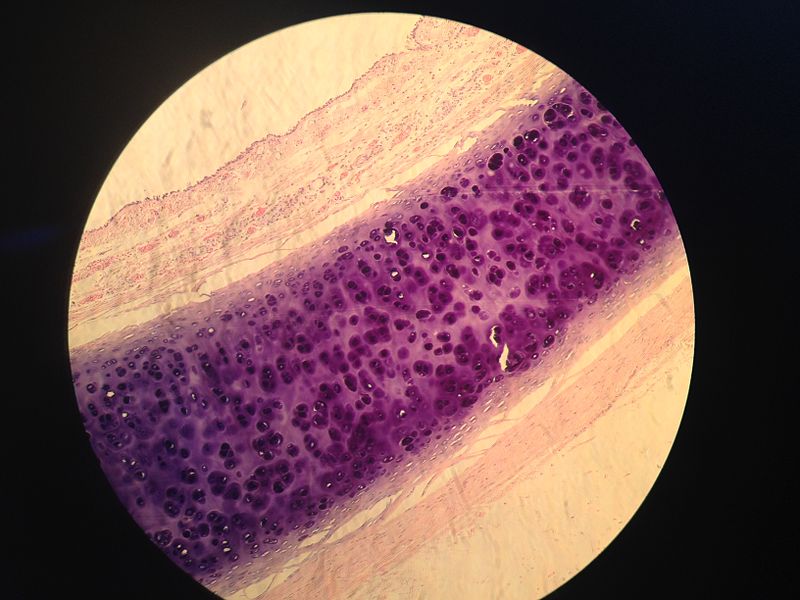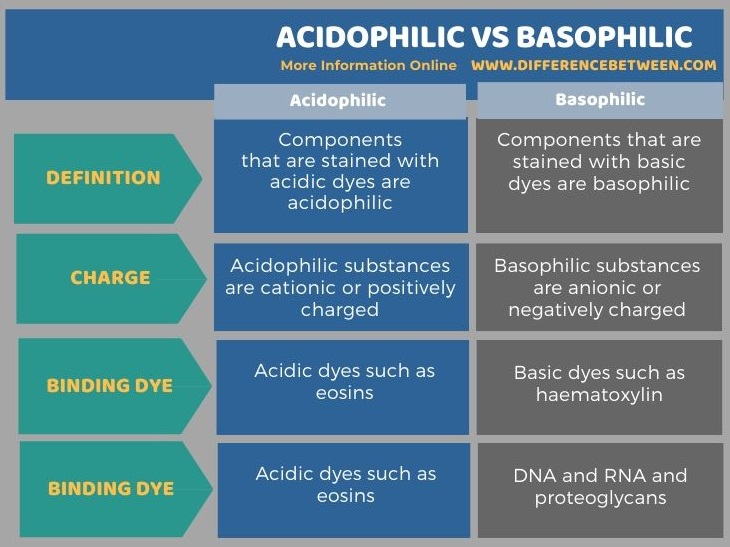The key difference between acidophilic and basophilic is that acidophilic components of a cell are acid-loving and acidic dyes are used to stain them while basophilic components of a cell are base-loving and basic dyes are used to stain them.
Staining is a technique used to visualize cells and their components since many cells are colourless and transparent. Some components of the cell are acid-loving, while some parts are base-loving. Acidic dyes and basic dyes are two types of dyes that are frequently used in stating procedures. Basophilic staining uses basic dyes while acidophilic staining uses acidic dyes. Therefore, acidophilic or acid-loving components bind with acidic dyes while basophilic or base loving components bind with basic dyes.
CONTENTS
1. Overview and Key Difference
2. What is Acidophilic
3. What is Basophilic
4. Similarities Between Acidophilic and Basophilic
5. Side by Side Comparison – Acidophilic vs Basophilic in Tabular Form
6. Summary
What is Acidophilic?
Acidophilic is a term used to refer to acid-loving components in the cell. Actually, acid-loving components are cationic (positively charged) or basic components in the cells. Cytoplasmic proteins are an example of acidophilic components. Proteins are positively charged at higher pH; hence they are acidophilic. Many proteins are acidophilic at physiological pH.

Figure 01: Staining of Cells with Basic and Acidic Dye
Once we add an acidic stain, acidic stains react with acidophilic components of the cell and visualize them. Eosin, Orange G, and acid fuschin are some acidic dyes.
What is Basophilic?
Basophilic components of the cells are base-loving parts of the cell. In fact, they are anionic (negatively charged) or acidic components in cells. They are attracted to basic dyes. Some examples of basophilic components are nucleic acids. Since nucleic acids have phosphate groups, they are negatively charged and attracted towards the basic dyes. Moreover, proteoglycans are basophilic due to their sugar and esterified sulfates. When we add a basic dye, basophilic components of the cells react with the basic dye and are stained by them. One example of a basic dye is haematoxylin. Methylene blue, alcian blue and toluidine blue are several other basic dyes.
What are the Similarities Between Acidophilic and Basophilic?
- A cell has both acidophilic and basophilic components.
- They are stained with their respective dyes.
- Both acidophilic and basophilic substances are charged components.
What is the Difference Between Acidophilic and Basophilic?
Acidophilic components of the cell are positively charged, while basophilic components of the cell are negatively charged. Therefore, acidophilic components are attracted towards acidic dyes while basophilic substances are attracted towards the basic dyes. So, this is the key difference between acidophilic and basophilic. Cytoplasmic proteins are acidophilic while nucleic acids are mainly basophilic. Furthermore, eosin is an acidic dye that stains acidophilic substances while haematoxylin is a basic dye which stains basophilic substances.
The following infographic presents the difference between acidophilic and basophilic in tabular form.

Summary – Acidophilic vs Basophilic
Acidophilic substances are acid-loving components of the cell. Hence, they can be stained with an acidic dye. Moreover, they are positively charged. In contrast, basophilic substances are base-loving components of the cells. They can be stained with a basic dye. Basophilic components are negatively charged. Many cytoplasmic proteins are acidophilic while nucleic acids are basophilic. Thus, this is the summary of the difference between acidophilic and basophilic.
Reference:
1. “Basophilic And Acidophilic Staining – Labce.Com, Laboratory Continuing Education”. Labce.Com, 2020, Available here.
2. “What Is Histology.” The Leeds Histology Guide, University of Leeds, 1 Jan. 1970, Available here.
Image Courtesy:
1. “Histological sample of Trachea obtained at “Instituto Nacional de Cardiología Ignacio A. Chávez” By Dr.Torres Valencia – Own work (CC BY-SA 3.0) via Commons Wikimedia
ncG1vNJzZmivp6x7pbXFn5yrnZ6YsqOx07CcnqZemLyue8OinZ%2Bdopq7pLGMm5ytr5Wau26twqKbqKiYnrmqr4yapZ1lkpbAsLzHoqOim18%3D